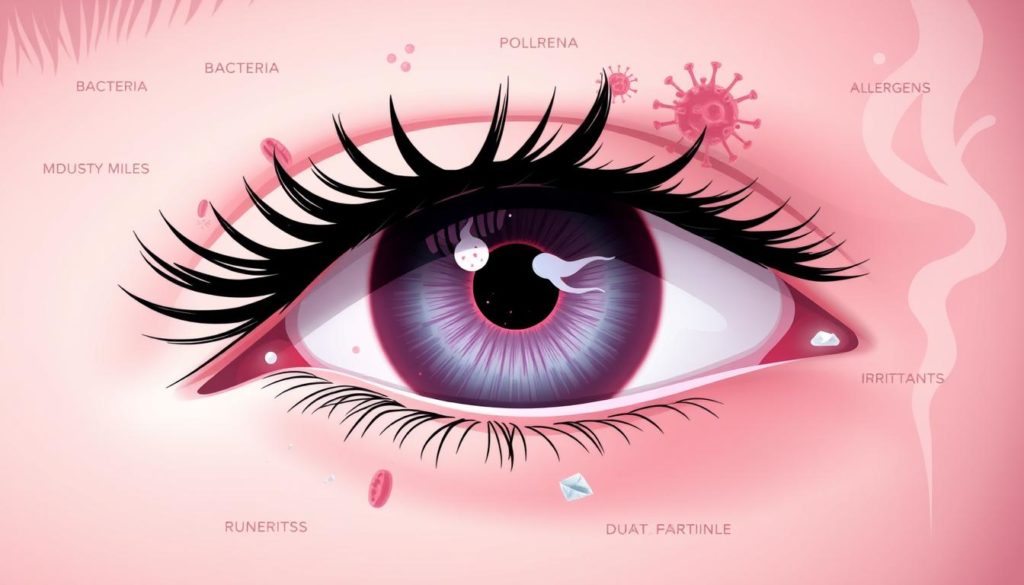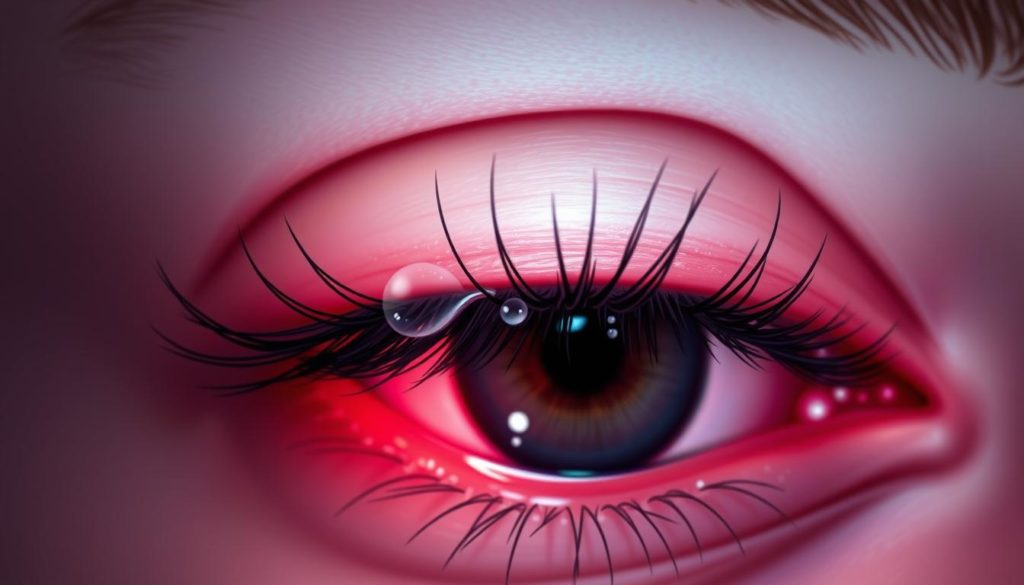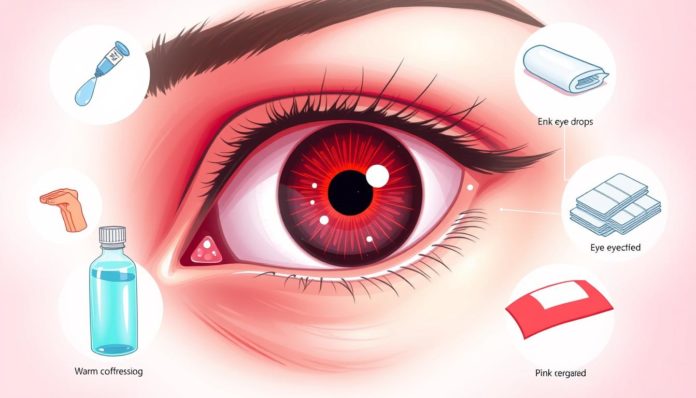Did you know almost 6 million Americans get pink eye every year? This common eye problem can make everyday tasks hard. It spreads quickly if we don’t handle it right.
Pink eye can happen because of viruses, bacteria, allergies, or irritants. Knowing the signs of pink eye is key. In this article, we talk about the main symptoms of pink eye. We also explore pink eye treatment options. These tips will help you find relief and keep others safe.
What is Pink Eye?
Pink eye, or conjunctivitis, is when the conjunctiva gets inflamed. This turns the whites of your eyes pink or reddish. Understanding what causes pink eye is key. This helps us manage and prevent it. It’s crucial because pink eye can easily spread from person to person.

Definition of Pink Eye
Conjunctivitis means the conjunctiva (the clear lining of your eyelid and eyeball) is inflamed. This makes the whites of your eyes look pink or red. It happens when tiny blood vessels get irritated.
Types of Conjunctivitis
There are three main types of pink eye, each caused by different things:
- Viral Conjunctivitis: Caused by viruses like adenovirus, this type is highly contagious and often starts in one eye before spreading to the other.
- Bacterial Conjunctivitis: Caused by bacteria, leading to pus and sticky eyes. It’s contagious but antibiotics can treat it.
- Allergic Conjunctivitis: Triggered by allergens like pollen or pet dander, it’s not contagious but causes itching and irritation.
| Type of Conjunctivitis | Cause | Contagious | Symptoms |
|---|---|---|---|
| Viral | Viruses (e.g., adenovirus) | Yes | Redness, watery discharge, starts in one eye, may spread |
| Bacterial | Bacteria (e.g., Staphylococcus) | Yes | Redness, sticky pus, swelling, starts in one eye, may spread |
| Allergic | Allergens (e.g., pollen, pet dander) | No | Redness, itching, tearing, usually affects both eyes |
Symptoms of Pink Eye
If you’ve ever had pink eye, you know it can be both uncomfortable and highly contagious. Recognizing the pink eye signs can help you act quickly.

Common Symptoms
Common symptoms of pink eye include:
- Redness in one or both eyes
- Itchiness
- Gritty feeling
- Discharge that forms a crust during the night
- Tearing
- Photophobia (sensitivity to light)
Pink eye signs range in how severe they are. Yet, any sign should prompt you to take care. Be extra careful if you use contact lenses. Stop wearing them if you notice symptoms.
When to See a Doctor
Sometimes, you can deal with pink eye on your own. But, if symptoms are bad, you need to see a doctor. You should get a pink eye diagnosis if you have:
- Severe pain in the eyes
- Blurred vision
- Intense redness
Experiencing these severe symptoms means you need a quick pink eye diagnosis. This is very important to avoid making things worse. Also, people with weaker immune systems, like those with diabetes, need to be extra watchful.
Causes of Pink Eye
Knowing why pink eye happens is key to stopping and treating it. It can come from many things like viruses, bacteria, allergies, and more.
Viral Infections
Viruses cause a lot of pink eye cases, especially the adenovirus. This goes along with colds and can spread fast in places like schools.
Bacterial Infections
Bad contact lens use and not keeping clean can lead to bacterial pink eye. This kind brings thick discharge and needs doctor’s care and antibiotics.
Allergic Reactions
Allergies to pollen, dust, or animal fur can cause pink eye too. It makes eyes red, itchy, and watery, often when allergies are worse.
Other Causes
Pink eye doesn’t just come from infections or allergies. Chemicals, small objects in the eye, or babies’ tear duct issues can also cause it. Each situation might need a different treatment.
Pink Eye in Children
Children are especially at risk for pediatric conjunctivitis, also known as pink eye. This condition shows through symptoms such as discharge, redness, and irritation in kids. It’s important to recognize these children’s pink eye symptoms early for effective treatment.
Ignoring these signs can cause serious issues, like ophthalmia neonatorum in newborns. Parents and caregivers need to get medical help quickly after spotting any symptoms. This helps prevent long-term damage to the child’s eyes.
Here’s a simple guide on spotting signs and taking correct action for pink eye:
- Symptom Recognition: Look for swollen eyelids, yellow-green discharge, and a lot of tearing.
- Immediate Action: Get medical help right away to stop conditions from getting worse.
- Daily Monitoring: Watch closely for any changes in the eye condition of your child.
Knowing how to deal with children’s pink eye symptoms is vital for their eye health. Prompt and proper care is crucial. It helps avoid complications and ensures a quick recovery.
Bacterial Pink Eye
Bacterial pink eye is also known by another name: bacterial conjunctivitis. It often shows up with pus-like discharge and eyelids that swell. Spotting bacterial conjunctivitis symptoms early, like red eyes, itching, and being quite puffy, is key to managing it well.
One notable thing about bacterial pink eye is how it connects to other infections, especially ear infections. This fact makes getting quick bacterial pink eye treatment crucial. It helps stop more problems and keeps it from spreading. Doctors usually give antibiotic eye drops or ointment as the main bacterial pink eye treatment.
Here are a few common bacterial conjunctivitis symptoms:
- Pus-like discharge from the eyes
- Swollen and red eyelids
- Itchy and irritated eyes
- Possible connection with ear infections
Knowing these symptoms and reacting fast helps stop bacterial conjunctivitis from spreading. It also means you can get back to normal quicker.
Viral Pink Eye
Viral pink eye, or viral conjunctivitis, often comes with a cold. It usually starts in one eye but can spread to both. The discharge is watery, not thick. Though no cure exists, supportive care eases the symptoms.
Symptoms and Diagnosis
Knowing the symptoms of viral conjunctivitis is key. Common signs include:
- Redness in the white of the eye or inner eyelid
- More tears than usual
- Watery discharge
- Itchy or irritated eyes
- Swollen lymph nodes near the ears
Doctors usually diagnose it based on symptoms and your health history. If it gets worse or doesn’t improve, seeing an eye doctor is vital.
Treatment Options
Though it can’t be cured directly, treating viral pink eye involves comfort measures. To ease discomfort, consider these options:
- Warm or cold compresses on the affected eye
- Artificial tears to keep the eyes moist
- Not wearing contact lenses until better
- Staying clean to avoid spreading it
Sometimes, doctors prescribe antiviral medicine for certain viruses, like herpes. Washing hands often and not sharing personal items are good ways to prevent spreading it.
Allergic Pink Eye
Allergic pink eye is also called allergic conjunctivitis. It affects both eyes. You might feel intense itching, have tears, and see redness.
This type isn’t like the viral or bacterial kinds because it doesn’t spread to others. It often comes with sneezing or an itchy nose too.
To manage it, people use allergy eye drops. These drops help reduce the annoying symptoms. Cold compresses and artificial tears also calm the irritation.
For a more lasting solution, doctors may suggest allergy immunotherapy.
If you’re looking for help, try clinics that specialize in eye issues. The Wilmer Eye Institute’s Ocular Surface Disease and Dry Eye Clinic gives custom treatments. They focus on allergic conjunctivitis and similar conditions for better eye care.
| Treatment Option | Purpose | Effectiveness |
|---|---|---|
| Allergy Eye Drops | Reduce itching and inflammation | High |
| Cold Compress | Soothe and reduce swelling | Moderate |
| Artificial Tears | Lubricate and moisturize the eyes | Moderate |
| Allergy Immunotherapy | Long-term allergy relief | High |
Knowing the symptoms and getting the right treatment is key. With proper care for allergic conjunctivitis, you can really boost your life quality.
How to Prevent Pink Eye
Good hygiene is key to stopping pink eye. Since it spreads easily, it’s important to keep up with habits that prevent it. Wash your hands often, don’t touch your eyes, and use clean towels. Here, we’ll explore more ways to keep your eyes clear.
Good Hygiene Practices
- Frequent handwashing with soap and water.
- Avoiding eye contact with your hands or unwashed fingers.
- Using clean towels and personal items at all times.
- Ensuring your eyeglasses and contact lenses are properly cleaned.
- Throwing away old eye cosmetics and avoiding sharing makeup.
It’s also vital not to share personal items like glasses or contacts. Practicing good hygiene is your best defense against pink eye. For tips on stopping its spread, check the CDC’s official page.
Preventing Pink Eye in Newborns
Newborns are at a high risk for pink eye. Doctors often use antibiotic ointment on babies’ eyes right after birth. This ointment keeps away bacterial infections that cause severe pink eye. It’s a common step in hospitals to protect babies’ health.
To learn how to protect newborns from pink eye, look into health guidelines.
Home Remedies for Pink Eye
Pink eye can make you feel really uncomfortable, but there are home remedies for pink eye that could help you feel better. A common method is using warm or cold compresses. Warm compresses are good for soothing the eye and reducing discomfort from viral or bacterial pink eye. Cold compresses work best for reducing itchiness and swelling from allergic reactions.
Another helpful remedy is over-the-counter eye drops, which can be a great natural conjunctivitis treatment. These drops keep your eyes moist and wash out any irritants. Make sure the drops are preservative-free to avoid more irritation.
To fight pink eye, it’s important to keep things clean. Make sure you wash your hands a lot. Don’t touch your eyes. Also, regularly clean or change things like your pillowcases and towels. This keeps the infection from spreading and coming back.
But remember, these home remedies for pink eye can only do so much. They aren’t a replacement for seeing a doctor. Always talk to a healthcare provider to get the right diagnosis and treatment plan. If your symptoms get worse or don’t get better in a few days, see a doctor right away.
FAQ
What are the common symptoms of pink eye?
The usual signs are eye redness and a gritty feeling. You may also feel itchy, have discharge that crusts over your lashes, experience tearing, and become sensitive to light. Pink eye can affect one or both eyes.
What causes pink eye?
Causes range from viral or bacterial infections to allergies. Chemical splashes or foreign objects in the eye also lead to pink eye. Each cause means different symptoms and treatments.
How is bacterial pink eye treated?
Doctors treat bacterial pink eye with antibiotic eye drops or ointments. Quick treatment is key to ease symptoms and stop it from spreading.
Can viral pink eye be treated?
While there’s no direct cure for viral pink eye, things like cool compresses and over-the-counter eye drops help with symptoms. It often gets better on its own in one to two weeks.
What are the symptoms of allergic pink eye?
Allergic pink eye usually hits both eyes causing intense itching and watery eyes. It comes with inflammation and maybe other allergy indicators like sneezing or an itchy nose.
How can I prevent pink eye?
Staying clean is vital. Wash your hands a lot, avoid touching your eyes, and use your own towels. Sharing personal items is a no-no, and throw away old makeup. For babies, doctors often use antibiotic ointment right after birth to stop bacterial infections.
Are there home remedies for pink eye?
Tackling discomfort at home can work. Try warm or cold compresses and over-the-counter eye drops. But, make sure to see a healthcare expert to get the right diagnosis and advice.
When should I see a doctor for pink eye?
Go see a doctor if your eyes really hurt, you can’t see well, or can’t stand light. If things don’t get better after a few days, it’s time for professional help. People who use contact lenses should stop using them at the first sign of trouble and see a doctor.
Is pink eye contagious?
Yes, types caused by bacteria or viruses can easily spread. Stick to good cleanliness to avoid passing it on. Yet, allergic pink eye cannot be caught from someone else.
What should I do if my child has pink eye?
If you see signs like discharge, redness, or irritation in your child’s eyes, contact a healthcare provider fast. Kids can catch it easily, and without treatment, it might lead to worse problems.
What are the specific hygiene practices to prevent pink eye?
Make sure to wash your hands often, don’t touch your eyes with them, and each person should use their own towel. Don’t share personal items like makeup, and remember to toss out old cosmetics. For new parents, applying antibiotic ointment to your newborn’s eyes is a smart preventive step.


